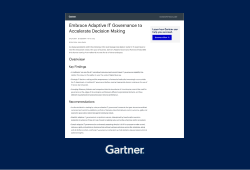10 best Product Portfolio Management software and tools for 2025: the ultimate guide
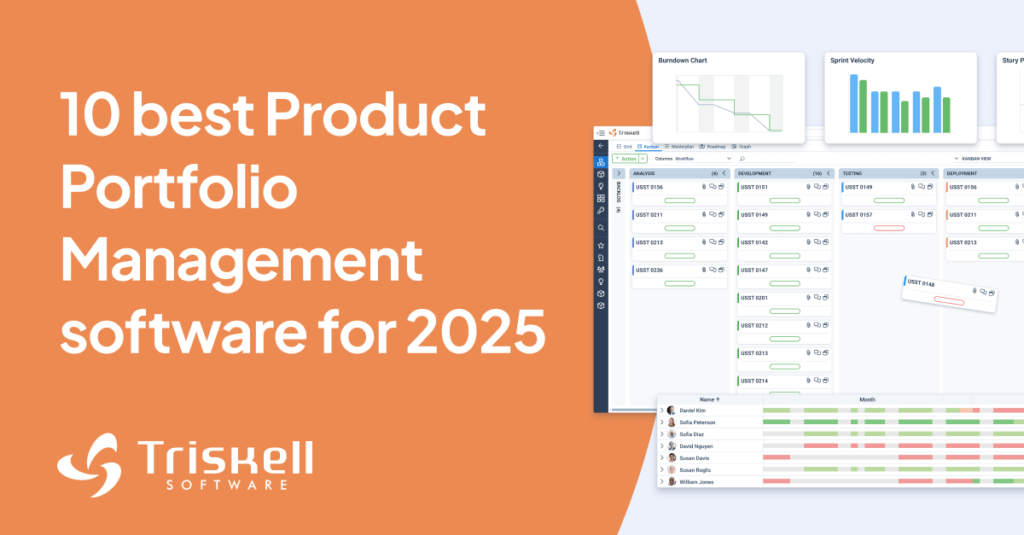
In today’s fast-paced business environment, spreadsheets and project management tools are no longer enough to successfully manage one or more product portfolios. More and more companies are turning to Project and Product Portfolio Management software to manage the entire product planning, development and marketing cycle from start to finish.
But, given the huge number of tools on the market, how to choose the one that best suits your needs? Don’t worry, we are here to help you. In this post, we are going to analyze the 10 best product portfolio management tools you can find today. We’ll show you their value propositions and the strengths and weaknesses of each, so you can compare and choose the best option for your organization.
What is Product Portfolio Management software?
But before we get to the heart of the matter, you may be wondering, what is a product portfolio management software? And, above all, how is it different from the project management tools you probably already use in your organization?
A product portfolio management software is a platform from which you can comprehensively manage a set of products in a structured and strategic way. Its goal is to optimize all phases of the product development lifecycle. This includes from idea generation to execution and delivery, while ensuring that each initiative always has the necessary resources and is aligned with business objectives.

PROJECT PORTFOLIO MANAGEMENT
Elevate your Product Portfolio Management with Triskell
Discover how Triskell’s Project Portfolio Management solution can lead your products to success.
With Product Portfolio Management software you get an overview of the performance of your portfolios. You will be able to measure how each product contributes to the overall company strategy. And, at the same time, you get information on resource utilization, financial performance, risks, market opportunities, and much more.
Key features in product portfolio management tools
This type of solution differs from other applications more focused on project management because of the scope of the features included. While tools such as Jira, Microsoft Project or Smartsheet are valid for managing individual projects, they are not as effective when it comes to managing project and product portfolios.
These are the key functionalities that differentiate the best PPM tools from other competitors in the PPM industry:
- Product Portfolio Planning: unlike project management software, these tools contain functionality that will not only help you prioritize your products based on value, risks and their alignment with strategy, but also help you predict future resource needs and performance metrics.
- Resource Management: Many of these solutions also contain specific modules for Resource Management. In them, you can not only allocate and track resource usage, but also plan capacity and help your organization prepare for future demand.
- Financial Management: A product portfolio management tool gives you visibility into the financial performance of your portfolios. You can manage costs, track budgets or analyze the ROI of your products.
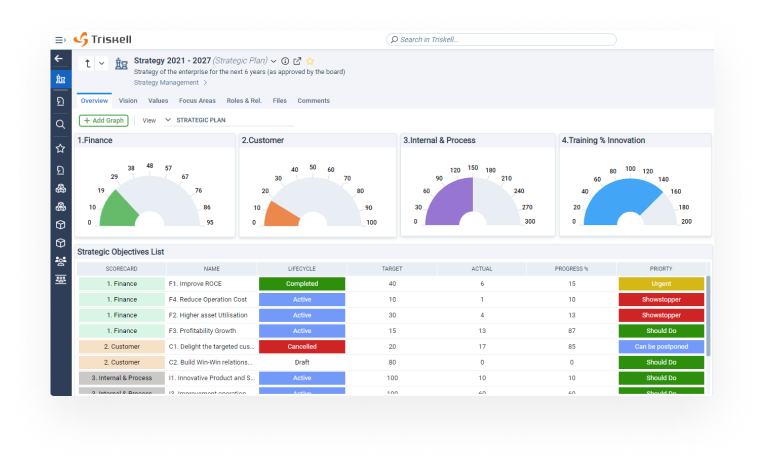
- Real-time reports and dashboards: you can configure different reports and dashboards, adapting them to the needs of each business role, to improve decision making.
- Scenario simulation: with the scenario simulation feature you can evaluate different strategic options and see their impact on the performance of your product portfolios. For example, changes in prioritization of initiatives, resource allocation or budget management.
- Demand and Idea Management: some solutions also include functionalities for capturing ideas and project requests. You can evaluate and prioritize them and integrate Demand Management with strategy planning and management processes.
- Collaboration and communication tools: features such as document sharing, alerts, notifications and feedback are critical for efficient product management.
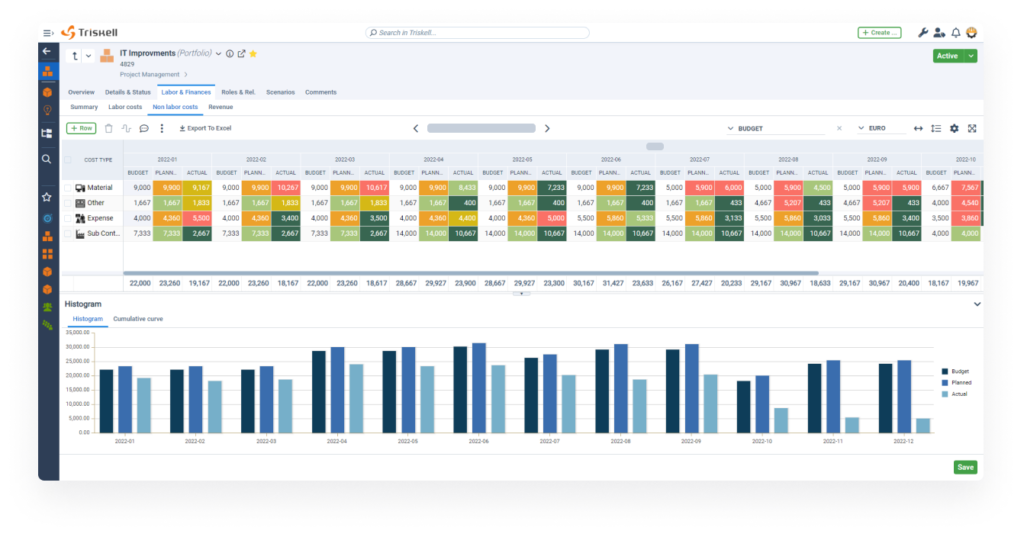
Benefits of Product Portfolio Management software
With all these features at your disposal, you can’t get an idea of all the benefits this type of solution will bring to your organization. Here are just a few of them:
- Improved alignment with strategy: these tools allow you to link projects, programs and products to objectives, also providing a clear view of the value that each product brings to the business. Therefore, your product teams will be able to focus on those activities that deliver the most value.
- Better resource allocation: you will gain real-time visibility into how resources are being used and where they should be allocated to have the greatest impact. And, at the same time, you will minimize bottlenecks and problems of over- or under-utilization of resources.
- Data-driven decision making: with Product Portfolio Management software, you will have real-time data and advanced analytics at your disposal, which will improve your decision making and the performance of your product portfolios.
- Enhanced agility: These tools also help organizations to be agile in adjusting product portfolios in the event of new market opportunities or changes in strategy, thus minimizing risks.
- Visibility at the portfolio level: Product portfolio management tools provide a top-down view of all initiatives, allowing managers to monitor performance, identify bottlenecks and make adjustments. No product portfolio will be left unattended thanks to the visibility provided by this type of solution.
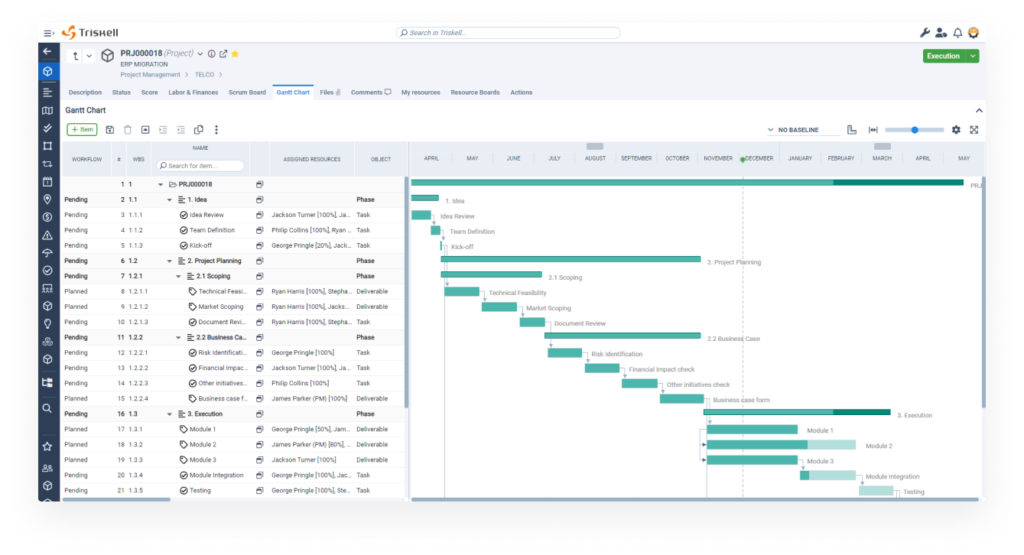
Selection criteria for product portfolio management software
When choosing the right product portfolio management software for your organization, you should not only consider whether the tool has the features listed above or the benefits that the solution will bring you.
It is a very complex decision, as you have to make sure that the tool aligns with your organization’s objectives, strategy and scale. So here are the criteria you should consider when evaluating a product portfolio management tool:
- Ease of use: during the evaluation process, you will be requesting demos or free trials of several tools. Well, you should make sure that the interface is intuitive and easy to use. If the tool is complex and requires many hours of training to master, it is best to consider other options.
- Scalability: you should make sure that the software can scale at the same pace as your business. Therefore, if you plan to expand your product portfolios in the medium or long term, the tool you choose must be able to handle this growth without compromising its performance.
- Integrations: Another critical aspect to take into account is that the software can integrate seamlessly with the company’s application ecosystem. This includes messaging applications, email, ERP systems, CRM, Jira and other project management tools.
- Flexibility: the tool must be flexible enough to be able to create workflows, reports and dashboards tailored to your organization’s needs and processes.
- Product management methodologies: whether you work with Phase-Gate, Scrum, DevOps or any other methodology for product management and development, you should look for a tool that can integrate all the methodologies you use in your organization.
- Pricing model: evaluate the pricing model of each software vendor. Don’t just look at the cost of each license, but also take into account other variables such as implementation and technical support.
- Customer service: and finally, make sure that the customer service offers customer service hours and SLAs adjusted to your company’s needs.
For more information on the more than 100 criteria to consider when purchasing Product Portfolio Management software, we invite you to download the following checklist.
PPM SOFTWARE CHECKLIST
A Comprehensive buyer’s checklist for PPM Software
Use this quick checklist to compare potential modern PPM solutions in order to pick the best one for your organization.
10 best Product Portfolio Management software and tools for 2025
Now that we’ve covered the key aspects of Product Portfolio Management software, let’s dive into the top 10 tools for 2025. These solutions stand out for their features, flexibility, and ability to help organizations effectively manage their product portfolios.
Product Portfolio Management tool #1: Triskell Software
Triskell Software is a robust Product Portfolio Management software that supports strategic planning, new product development and resource and capacity planning. Its scalability and flexibility make it one of the most versatile tools, suited for complex enterprise needs across various industries.
Planning and New product development in one place
Triskell’s main differentiator is that it is an all-in-one solution that provides end-to-end visibility into the entire lifecycle of all your projects and products. From idea generation to development and final product launch, with Triskell you can plan, track and execute all initiatives within a single PPM platform.
Its scalability makes it ideal for medium to large corporations that manage multiple product portfolios across different teams and departments. In addition, it is a highly customizable tool, where you can replicate the processes, workflows, fields and reports you already use in your company.
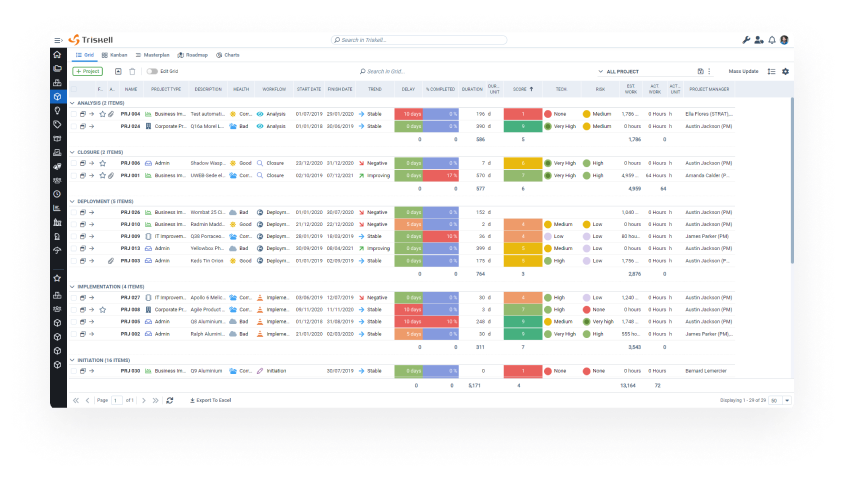
A PPM platform that fits Agile and Phase-Gate processes
It doesn’t matter if your organization works with Scrum, DevOps, Phase-Gate, Waterfall, Lean or any other Agile framework. Triskell accommodates any project management methodology, including hybrid management approaches. This flexibility is especially useful for organizations seeking a balance between innovation and quality control.
Whether some initiatives require iterative development or follow a more linear process, with Triskell your teams can switch management methodologies as needed. Or even work some product phases with a more traditional approach and others with one of the Agile frameworks.

AGILE PORTFOLIO MANAGEMENT
Boost agility and deliver value faster with Triskell
See how Triskell’s Agile Portfolio Management solution can streamline your product development lifecycle.
Advanced Resource and Financial Management capabilities
Another of Triskell’s strengths is its comprehensive resource and financial management capabilities. Triskell allows users to efficiently allocate resources across multiple projects and portfolios, ensuring that no team is overwhelmed or underutilized. The platform also integrates financial data, making it easy to track costs, budgets and ROI for each product.
With Triskell, you can plan capacity, forecast resource needs, identify gaps and dynamically reallocate resources based on changing priorities. Financial management tools provide clear visibility into project profitability and cost performance, helping managers control both resources and budgets.
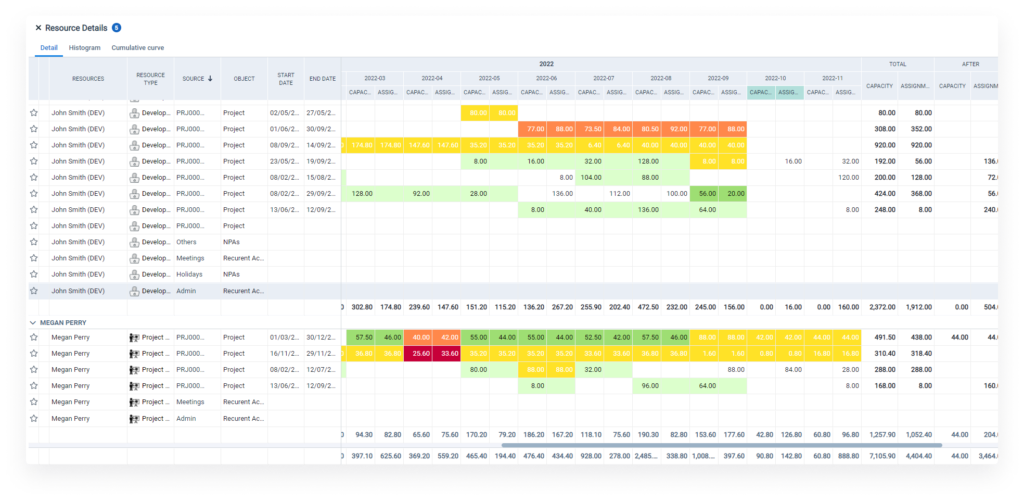
Idea and Demand Management hub
Triskell features a powerful idea and demand management hub that allows teams to capture, evaluate, and prioritize new ideas. This ensures that the most valuable and strategically aligned ideas are brought into the product pipeline. By providing a structured approach to idea management, Triskell ensures that innovation is constantly feeding into the portfolio without overloading teams.
Therefore, Triskell helps to streamline the decision-making process, ensuring that only the best ideas are moved forward into development. It also offers a clear audit trail for why certain ideas were pursued or rejected, helping to build consensus and strategic focus.
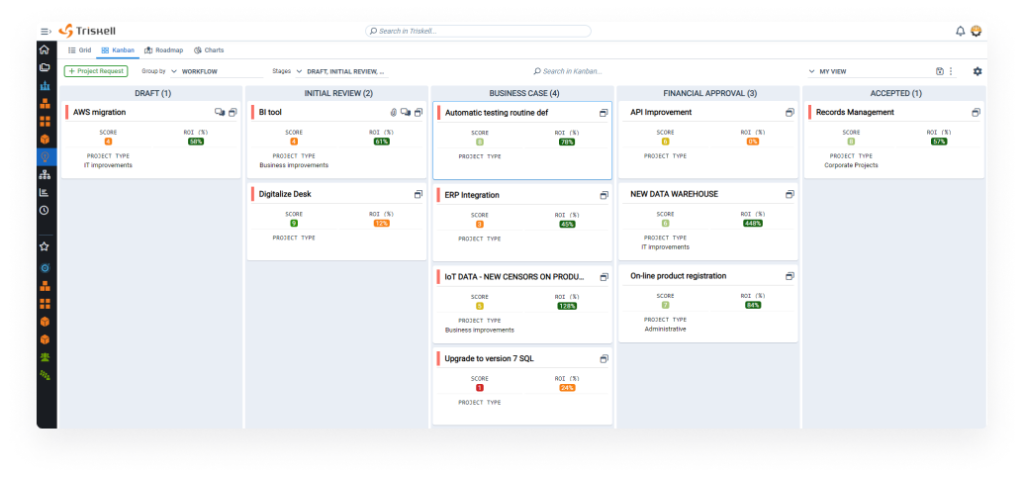
Integrations
Triskell can integrate through its API with a wide range of enterprise applications. This includes:
- ERP systems.
- SAP.
- CRM tools.
- Oracle.
- Power BI.
- Azure DevOps
- Microsoft suite products.
- Other Project Management tools (Jira, Microsoft Project).
- Etc.
Other key features of Triskell Software
- Scenario Simulation: with Triskell you can evaluate different scenarios based on multiple variables (product prioritization, resource allocation, budget, etc.), and make the best decisions to maximize portfolio performance.
- Real-time reporting and dashboards: customize reports and dashboards according to the needs of each stakeholder.
- Customizable workflows: you can customize workflows in the tool to fit the specific needs of your organization.
Triskell cons and areas of improvement
- Complexity for small organizations: The platform’s extensive capabilities could be more than what small teams need, making it feel complex for those managing only a few projects.
- Learning curve: Due to its robust functionalities, there may be a steep learning curve for new users.
Triskell pricing
Custom pricing. Contact the sales teams for more details.
Triskell reviews
- Capterra: 4.7/5
- G2: 4.4/5
Triskell in overall is a great software but specifically, its ability to strategize and allocate resources in accordance with the company’s objectives and priorities is excellent
Ready to streamline your product portfolios?
Request a demo of Triskell today and discover how it can help you prioritize, plan, and manage your product roadmap.
Product Portfolio Management tool #2: Planisware Orchestra
Planisware Orchestra helps organizations to streamline product development and manage complex project and product portfolios. It provides comprehensive solutions for overseeing product lifecycles, resource allocation, and innovation management.
Key features of Planisware Orchestra
- Comprehensive feature set: it integrates project management, resource management, budgeting, time tracking and even custom features like non-conformity treatment in one single tool.
- Customization: with Planisware, you can tailor stages, gates, and workflows to specific project types and organizational needs.
- Resource allocation: It allows a detailed allocation by hours, FTEs, percentages or days, which facilitates the tracking of project tasks and resource usage.
- Integrations: Planisware offers several integration possibilities with tools like Google Workspace, flat files, and reporting tools.
Planisware Orchestra cons and areas of improvement
- Reporting limitations: reporting tools, especially for Gantt and customizable reports, need improvement due to inconsistent naming within the tool and limited batch actions.
- Agile support: its Agile management features, such as Kanban boards, could be better integrated and more user-friendly.
- Document Management: access to uploaded documents within the tool is restricted.
- User interface: the UI needs improvement in several areas, like Gantt charts, timeline management and reporting.
Planisware Orchestra pricing
Custom pricing.
Planisware Orchestra reviews
- Capterra: 4.2/5
- G2: 4.0/5
This tool is very robust and complete for the management and programming of projects in a company
Product Portfolio Management tool #3: Planview PPM Pro
Planview PPM Pro is an Enterprise PPM solution designed to manage product portfolios and drive business outcomes. It offers deep reporting capabilities and support for both Agile and traditional project management approaches.
Key features of Planview PPM Pro
- Comprehensive features: it includes features for request capturing, portfolio and asset management, stage gating, time tracking, and financial management.
- Customizability: Planview users can manage requests, projects, and resources flexibly with advanced customization options in building workflows and tailoring project lists.
- Reports and dashboards: they have multiple customization options and offer clear data visualization.
Planview PPM pro cons and areas of improvement
- Performance issues: the platform can be slow and cumbersome, with long loading times for updates and task management, especially in Chrome and Internet Explorer.
- Report generation: developing custom reports often requires technical know-how, and training is necessary for efficient use.
- Usability issues: submenus are sometimes hard to find, and the Gantt chart view cutting off description is quite challenging to use.
Planview PPM pro pricing
Custom pricing.
Planview PPM pro reviews
- Capterra: 4.0/5
- G2: 3.8/5
This is an amazing project management software that creates and manages project timelines and organization. It enables us to easily track hours of project tasks and activities and time on deadlines
SUBSCRIBE TO OUR NEWSLETTER
Get stories like this in your inbox
Product Portfolio Management tool #4: aha!
aha! is a widely used Product Portfolio Management software known for its intuitive roadmapping features. It helps organizations streamline product planning and ensure alignment between product goals and business objectives.
Key features of aha!
- Product roadmapping: users appreciate the ability to organize and prioritize product features and tasks effectively.
- Reporting and visualization: aha! Allows to create dynamic reports and visualizations that link strategic goals to product features, enhancing alignment across teams.
- Training: the availability of educational videos and a knowledge base aids users in their learning process of the tool.
- Software maintenance: new features and improvements are released very often.
aha! cons and areas of improvement
- Cost: it´s an expensive tool, particularly when adding multiple users.
- Feature overload: it has so many features that, for new users, it can be difficult to find or learn all of them.
- Integration with Jira: although Aha! can integrate with many tools such as Azure DevOps or Salesforce, integration with Jira is challenging.
- No OKR support: the lack of OKR support is a significant gap in the tool. So, if your organization works with this methodology, maybe it´s not the best fit.
aha! pricing
- Aha! Whiteboards: 9$ per user / month
- Aha! Develop: 9$ per user / month
- Aha! Ideas: 39$ per user / month
- Aha! knowledge: 39$ per user / month
- Aha! roadmaps: 59$ per user / month
aha! reviews
- Capterra: 4.7/5
- G2: 4.4/5
Aha has been great for our organization to provide visibility across our product portfolio and visualize the progress on our initiatives

NEW PRODUCT DEVELOPMENT
Drive innovation in Product Development
See how Triskell’s New Product Development solution can help you to optimize your product development processes.
Product Portfolio Management tool #5: ProductPlan
ProductPlan is an intuitive roadmap planning software that allows users to build, share, and present roadmaps in real-time. The tool is focused on improving collaboration and strategic planning by giving a clear view of product progress and portfolio performance.
Key features of ProductPlan
- Roadmap: users love the clean, visually pleasing Gantt-style roadmaps that ProductPlan generates.
- Visual features: functionalities like zooming in and out and swimlanes for different teams or projects add flexibility to the visualization.
- Integrations: it integrates well with tools Jira, Azure DevOps, Slack, and SharePoint, which adds value for teams managing development work and needing up-to-date status on project progress.
- Collaborative tools: its ability to share dynamic views and customized roadmaps with stakeholders is remarkable.
ProductPlan cons and areas of improvement
- Limited roadmap features: ProductPlan’s roadmap can become clunky when trying to display them for multiple teams.
- Exporting limitations: the exporting options can be improved, especially when trying to present roadmaps in formats like Power Point.
- Pricing of basic features: Single-Sign-On requires additional pricing, which can be restrictive.
- Sharing option: sharing roadmaps with external stakeholders is not allowed, you would need to pay for additional licenses.
ProductPlan pricing
Custom pricing.
ProductPlan reviews
- Capterra: 4.4/5
- G2: 4.4/5
I like this software not only for the simple fact that you can have a sheet where you can see the products offered by the company and the marketing strategy and method, but you can also describe each product
Product Portfolio Management tool #6: Sciforma
Sciforma is a robust Product Portfolio Management software that offers end-to-end solutions for managing projects, resources, and product portfolios. It provides flexible, customizable tools for overseeing product lifecycles, risk management, and financial tracking.
Key features of Sciforma
- Resource and capacity management: tools for capacity planning, budget tracking, and milestone management are seen as highly effective by most users.
- Flexibility: with Sciforma you can tailor reports, dashboards, and workflows to meet the specific needs of your organization.
- Hybrid approach: Sciforma supports various project management methodologies, including hybrid approaches that blend traditional and Agile frameworks.
Sciforma cons and areas of improvement
- Reporting limitations: the default reports lack in detailed automation, forcing users to resort to BI tools for more advanced reporting.
- Performance issues: the system sometimes takes up to 10 seconds to load pages, especially when performing multiple operations quickly.
- User interface: it´s clumsy and non-intuitive.
Sciforma pricing
Custom prising.
Sciforma reviews
- Capterra: 4.4/5
- G2: 4.2/5
It is a software that focuses most of all on the success of providing a flexible platform for the management of multiple project environments
Ready to streamline your product portfolios?
Request a demo of Triskell today and discover how it can help you prioritize, plan, and manage your product roadmap.
Product Portfolio Management tool #7: Workfront
Adobe Workfront is a work management platform that helps teams collaborate on product development, manage workflows, and track project performance. It enables organizations to prioritize tasks, allocate resources efficiently, and deliver products on time while maintaining strategic alignment with overall business goals.
Key features of Workfront
- Comprehensive Project Management: it includes several project management features, including scheduling, assigning tasks, tracking milestones, and providing detailed reporting.
- Customization and flexibility: users can tailor workflows, project templates, and even automate reporting and task assignment.
- Automation and predictive features: you can forecast project timelines, costs, and resource allocation.
- Collaboration features: file sharing, real-time communication, and the ability to manage team dependencies are some of the collaborative tools included.
Workfront cons and areas of improvement
- Notification overload: even with customization options, the application sends a lot of email notifications.
- Lack of out-of-the-Box features: While Workfront is highly customizable, we think that the out-of-the-box features are quite limited.
- System performance: login issues are quite common, especially in enterprise environments where multiple users try to log in at the same time. Also, file uploads and UI interactions are slow.
Workfront pricing
Custom pricing.
Workfront reviews
- Capterra: 4.4/5
- G2: 4.1/5
I love its ability to schedule, track, and limit resources at the task level, allowing PMs to effectively manage the budget without needing to micromanage
EBOOK
PPM Software Buyers’ Guide
What should you look for in a new PPM tool?
Product Portfolio Management tool #8: ProdPad
ProdPad is an intuitive Product Portfolio Management tool designed for managing ideas, prioritizing features, and building product roadmaps. It focuses on early-stage product development and backlog management, allowing teams to capture feedback and streamline innovation.
Key features of ProdPad
- Roadmap management: the “Now, Next, Later” framework for prioritization and roadmaps without timelines, allowing teams to focus on value without being tied to rigid timelines.
- Customer feedback management: Prodpad includes a feedback portal, where you can link feedback directly with ideas and initiatives.
- AI features: it includes AI capabilities for generating product stories and initiatives are quite robust.
- Visual design: visually speaking, ProdPad is compelling, which is appreciated for presenting ideas, feedback, and roadmaps to stakeholders or executives.
ProdPad cons and areas of improvement
- Customization options: its roadmaps could be better if they include additional reporting and visualization features, particularly for portfolio-level decisions.
- Missing features: besides reporting features, it´s also missed more advanced resource allocation capabilities or custom statuses for ideas beyond basic ones like ‘archived’ or ‘backlog’.
- Integration with Jira: although ProdPad integrates with Jira, there are several issues, like syncing epics and user stories, and also limitations in customizing the integration to meet complex needs.
ProdPad pricing
- Free.
- Roadmaps essentials: $24 per user/month.
- Roadmaps advanced: $44 per user/month.
- Ideas essentials: $24 per user/month.
- Ideas advanced: $36 per user/month.
- Feedback essentials: $24 per user/month.
- Feedback advanced: $44 per user/month.
ProdPad reviews
- Capterra: 4.0/5
- G2: 4.3/5
I like that Prodpad links customer directly directly to ideas, initiatives and OKRs, making sure that customer feedback is available where decisions on a product are made
Ready to streamline your product portfolios?
Request a demo of Triskell today and discover how it can help you prioritize, plan, and manage your product roadmap.
Product Portfolio Management tool #9: Oracle PLM Cloud
Oracle PLM Cloud is a comprehensive Product Lifecycle Management solution that supports innovation and product portfolio management from concept to market. It enables organizations to streamline product development processes, optimize resource utilization, and ensure compliance with industry standards.
Key features of Oracle PLM Cloud
- Comprehensive features: it provides well-structured modules such as innovation management, product data hub (PDH), product development (PD), and quality management (PQMS).
- Change Management: features like the DCR/DCO (Document Change Request/Document Change Order) process are well integrated within the tool.
- Integrations: the platform also offers connectors for seamless integration with other systems, especially within the Oracle ecosystem.
Oracle PLM Cloud cons and areas of improvement
- Learning curve: the platform can be confusing initially. The user manual and support for new users can be lacking, and training options are somewhat limited for the cloud version.
- Performance issues: slowness issues are quite common, especially when downloading or uploading large files.
- Limited reporting: reports are not structured well for export, particularly into Excel. And data analysis options are quite limited.
Oracle PLM Cloud pricing
Custom pricing.
Workfront reviews
- Capterra: 4.3/5
- G2: 4.0/5
PLM helps us in maintaining the product data management in an efficient and easy to use way
EBOOK
PPM Software Buyers’ Guide
What should you look for in a new PPM tool?
Product Portfolio Management tool #10: Celoxis
And the last Product Portfolio Management software of the list is Celoxis, a project management tool that supports resource management, project tracking, and portfolio optimization. Its flexible features allow teams to manage both traditional and agile projects.
Key features of Celoxis
- Portfolio and Task Management: managing inter-project dependencies and portfolio-level insights is intuitive.
- Integrations: Celoxis integrates well with popular tools like Google Drive, QuickBooks, and email/calendar apps
- Project management features: Celoxis is highly praised for its extensive project management features, including Gantt charts, resource allocation, time tracking, customizable dashboards, and reporting.
Celoxis cons and areas of improvement
- Performance issues: lags and slower page loads are quite frequent, particularly when dealing with larger projects or more complex dashboards.
- Learning curve: Celoxis offers so many features that users may find it overwhelming at first, and getting comfortable with the advanced functionalities can take time.
- Mobile app: the mobile app is even more unstable than the desktop version.
Celoxis pricing
- Team member: 15$ per user/month.
- Manager: 25$ per user/month.
Celoxis reviews
- Capterra: 4.4/5
- G2: 4.5/5
Celoxis enables my team to organize client projects and track portfolio performance. It provides work criteria for classifying projects based on their demands to ensure deadlines are met on time.
Conclusion: what´s the best Product Portfolio Management software?
Product Portfolio Management (PPM) software has become an indispensable tool for organizations managing multiple products or projects across their lifecycle. The ability to align product strategies with business goals, optimize resource allocation, and manage risks is essential in today’s fast-paced market. Among the top PPM tools for 2025, Triskell Software stands out due to its flexibility, advanced resource and financial management capabilities, and support for both Agile and Phase-Gate processes.
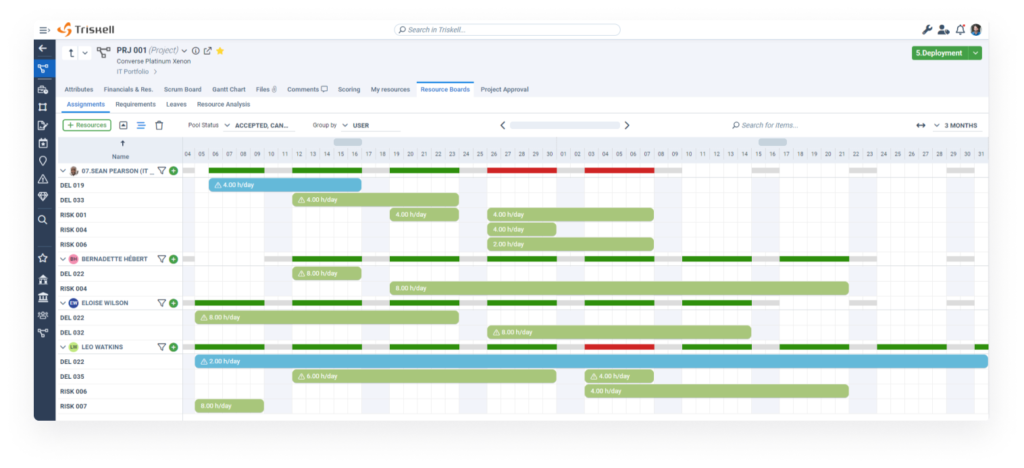
While each PPM tool offers its own set of strengths, the choice ultimately depends on your organization’s specific needs, from the scale of operations to integration requirements and preferred project methodologies. Whether you’re looking for comprehensive resource management, financial oversight, or better collaboration across teams, selecting the right PPM software can greatly enhance your product management and overall business success.
Request a demo of Triskell Software
Triskell meets all the requirements for your organization’s PMO to take a step forward in aligning your project portfolio with strategic planning.
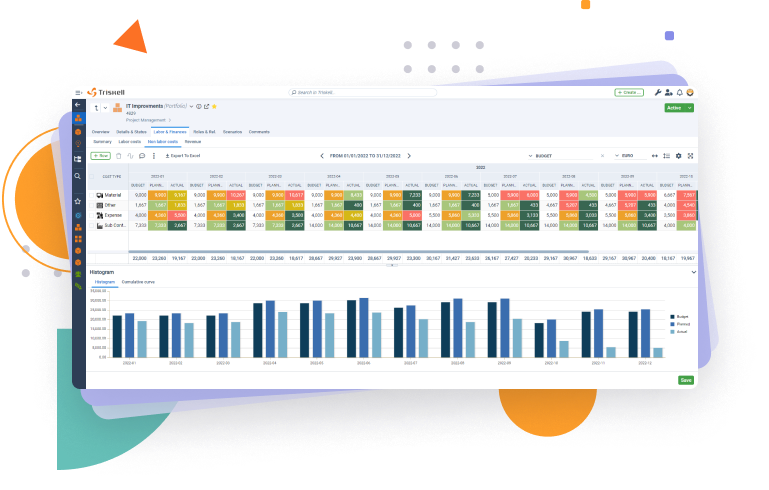
Related Content

10 types of Project Management Offices (PMO): structure, purpose and how to choose the right one
Learn about different PMO types, their governance levels, and which one is the best fit for your company’s project management needs.

How to create a project budget: methods and techniques for effective project budgeting
Learn how to create a project budget with this detailed guide. Discover essential methods and techniques for effective project budgeting in PPM.

20 strategic planning models and tools for medium and large companies
Looking for the best strategic planning frameworks? This guide covers 20 proven models to enhance decision-making and business growth.
FAQ Product Portfolio Management software and tools
Which business roles can benefit from Product Portfolio Management software?
Many roles across the organization can benefit from PPM software, including:
- Executives: Gain strategic insights into the overall portfolio, helping them make informed, high-level decisions.
- PMO Managers: Ensure that the portfolio is aligned with business goals and efficiently managed.
- Project Managers: Manage individual projects while maintaining alignment with the broader portfolio strategy.
- IT Managers: Oversee resource allocation and manage project dependencies.
- Financial Controllers: Monitor budgets, control costs, and track ROI for projects across the portfolio.
- Stakeholders: Access real-time data to understand the progress and performance of products within the portfolio.
How does Product Portfolio Management software support innovation and idea management?
PPM tools often come with idea management hubs that allow teams to capture and prioritize innovative ideas. This ensures that the most valuable ideas are developed into products, helping organizations maintain a competitive edge by fostering ongoing innovation.
What’s the difference between Product Portfolio Management software and traditional project management tools?
Product Portfolio Management tools focus on managing a collection of projects or products as part of a broader portfolio, aligning them with business strategy. Traditional project management tools focus on individual projects and typically lack the features needed for strategic, high-level portfolio management.

